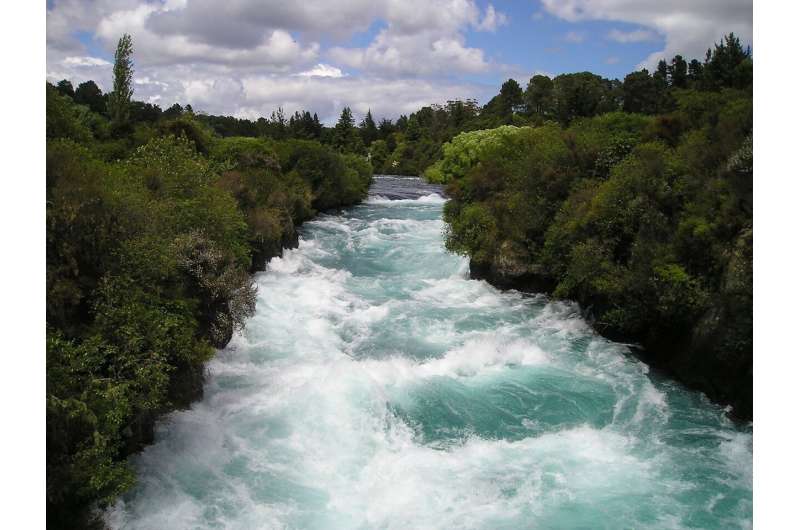This article has been reviewed according to Science X's editorial process and policies. Editors have highlighted the following attributes while ensuring the content's credibility:
fact-checked
trusted source
proofread
Q&A: Can a centuries-old technology like hydropower meet AI's rising energy demands?

Surging demand for the data and processing power of artificial intelligence is putting a hidden strain on U.S. electrical grids.
Generative AI systems like ChatGPT can each consume as much electricity in a single day as 180,000 typical U.S. households. The energy required to train these large language AI models is even more staggering: Training GPT-4 required over 50 gigawatt-hours, about 0.02% of California's annual electricity output and 50 times more than what was used for GPT-3.
As AI adoption grows, California's largest utility, PG&E, forecasts demand could double by 2040.
Shon Hiatt, an associate professor at the USC Marshall School of Business and director of the Business of Energy Transition initiative, sees hydropower as a promising solution. This centuries-old, clean and renewable energy source is underutilized in the United States, says Hiatt, but could play a crucial role in powering the AI revolution—and could help ease the pressure on national electrical grids.
During Green Week, USC News spoke with Hiatt to explore how hydropower could help meet AI's rising energy needs and support a more sustainable future.
What challenges does the AI revolution present in terms of energy consumption?
U.S. electricity demand is projected to surge over the next five years, with growth rates doubling from last year's estimates. This sudden increase is driven by three main factors: the rise of AI data centers, federally subsidized manufacturing plants and widespread electric vehicle adoption.
Because data centers require constant, reliable power, renewable sources like wind and solar can't provide without massive battery backup. As a result, utilities will need to rely more on natural gas, coal and nuclear plants to meet the increasing demand.
Looking ahead, electricity demand for data centers is projected to increase by 13%-15% annually through 2030. There is not enough planned electricity generation development to accommodate projected AI data center growth.
This is driving Big Tech companies into the energy sector, as seen in Amazon's recent $650 million deal to acquire a Pennsylvania data center powered by an on-site 2.5 gigawatt nuclear plant. As the demand for electricity continues to grow, it's clear that the energy landscape is undergoing a significant transformation.
How can hydropower help address these challenges?
A relatively quick solution is repowering existing hydropower plants and putting turbines on existing reservoirs.
Hydropower can provide baseload energy unlike wind and solar, which are intermittent due to clouds, weather, etc.
We are not building any new reservoirs (dams) in this country. That does not mean we cannot increase hydropower from existing reservoirs, however. The U.S. Department of Energy estimates that up to 10 gigawatts of energy can be created by upgrading existing powered facilities. This is something that can be done within months with capital.
Moreover, less than 3% of the more than 90,000 reservoirs in the United States produce power. Installing turbines and generators on these reservoirs could provide an additional 12 gigawatts of power. Putting turbines on existing reservoirs can also be done in a timely manner—in some states, a matter of months.
What are the advantages of investing in hydropower over other renewable energy sources to support AI's growing demand?
Every energy source has a tradeoff. Solar scales linearly and has thus the largest land footprint of existing power sources. Wind can affect birds and sea life. Nuclear and combined cycle natural gas have the smallest footprint for energy output.
Run-of-the river hydropower has much lower environmental impact than reservoir hydropower as it requires no reservoirs. Run of the river diverts some water from a watershed to power a turbine downstream while the rest of the water flows down the mountain.
The U.S. Department of Energy estimates that the U.S. has 65 gigawatts of unexploited hydropower energy that can come from ecologically friendly run-of-the-river facilities. However, development of run-of-the-river facilities can take years to develop due to government licensing and permitting barriers.
Frankly, it is likely that the demand for electricity for AI data centers over the next five years will be met by new combined cycle natural gas facilities. They are quick to put up, require a small footprint, and the U.S. currently has a large abundance of cheap gas. Small modular nuclear reactors are another potential solution. However, they are not likely to come online until 2030 at the earliest.

















